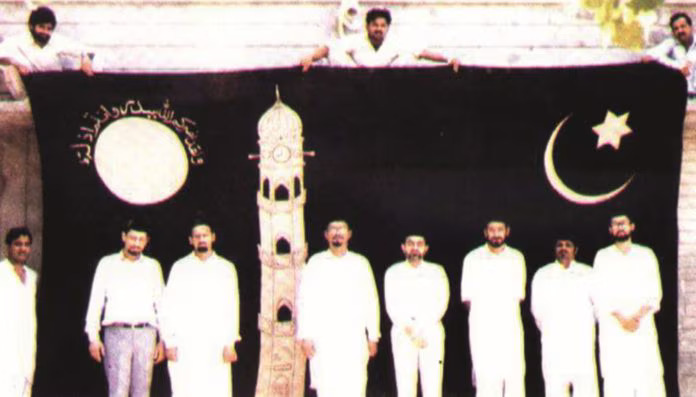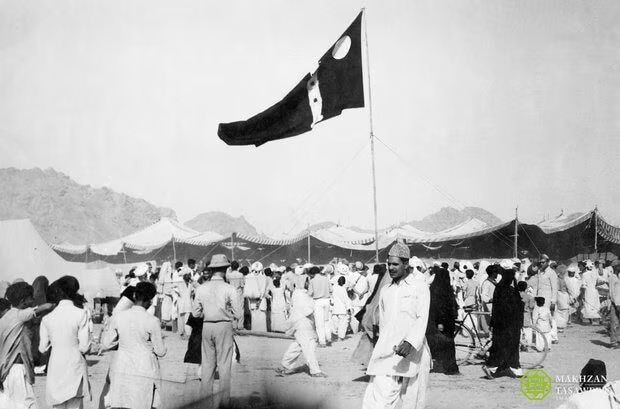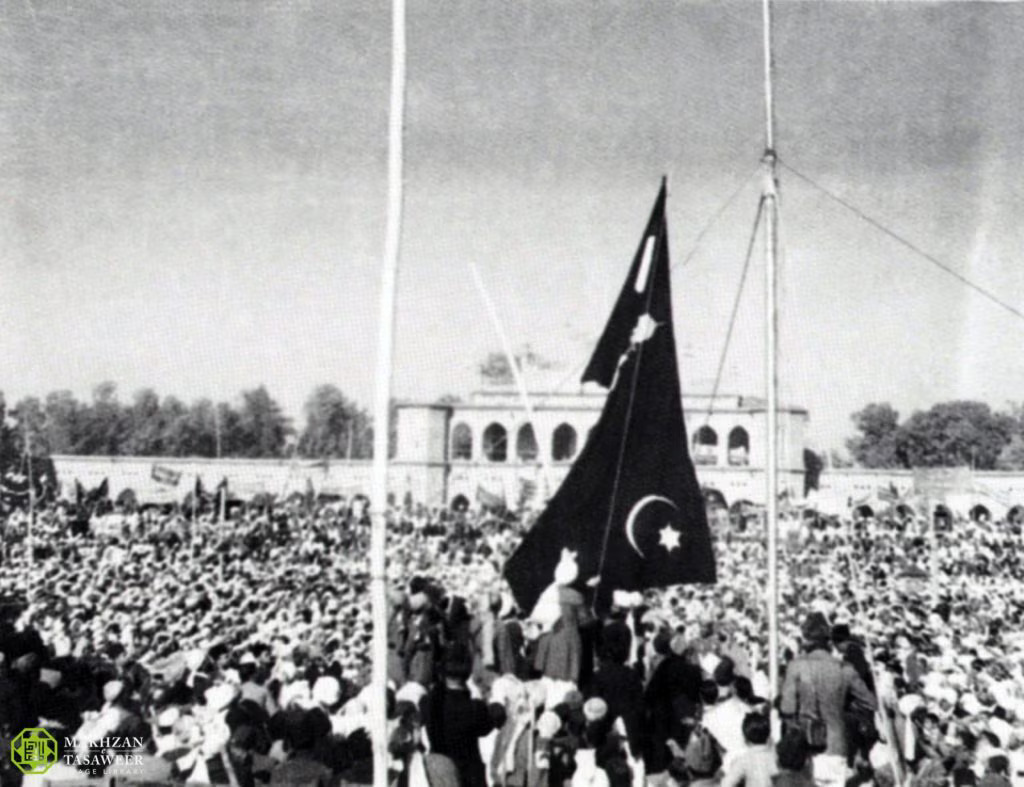
We see the flag of Jama’at Ahmadiyya fluttering proudly at Jalsa, and we look up and wonder about its prominence, meaning, and history. The Liwa-e-Ahmadiyya is one of four flags of the Jama’at, alongside the flags of Khuddam-ul-Ahmadiyya, Lajna-Ima’illah, and Ansarullah. All these flags have a rich history and deep meaning.
Liwa-e-Ahmadiyya:
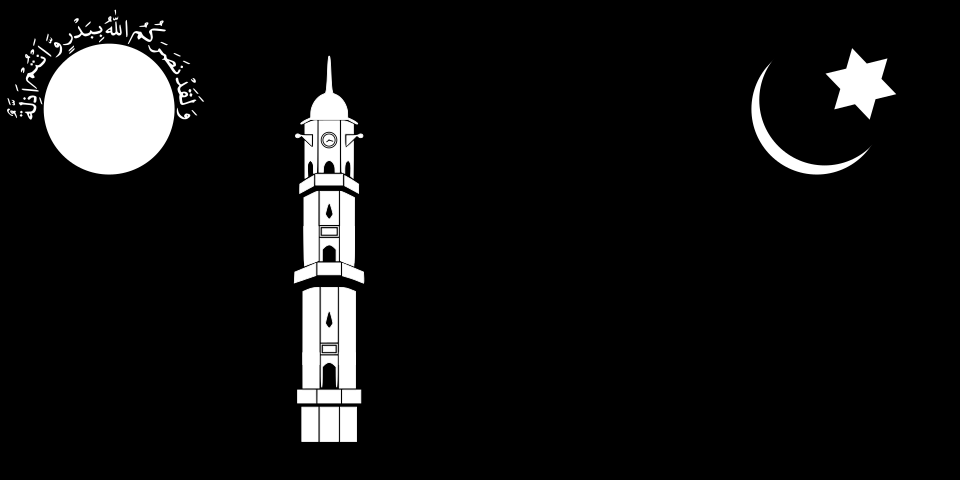
Hazrat Musleh Maud (may Allah be pleased with him) raised the Liwa-e-Ahmadiyya on December 28th, 1939, at Jalsa Qadian. Sir Chaudhary Zafrullah Khan Sahib (may Allah be pleased with him) suggested to Huzoor (may Allah be pleased with him) that the Jama’at should do something to celebrate its golden jubilee as well as the silver jubilee of Hazrat Khalifatul Masih II (may Allah be pleased with him), being the Khalifa. The idea of the flag was brought up in the Shura by Hazrat Mir Muhammad Ishaq (may Allah be pleased with him), who expressed that once the Holy Prophet Muhammad (peace and blessings of Allah be upon him) went to offer the Eid prayer in Madinah, and a flag was hoisted at the Eidgah. Similarly, a flag was hoisted on the occasion of Hajjat-ul-Wida.
At first, 376 members voted in favor of this, but some Jama’at members raised concerns that a flag is a sign of political representation of a state or country, and as such, it would be inappropriate for the Jama’at to have a flag. After this matter was discussed by Jama’at scholars, the proposal for Liwa-e-Ahmadiyya was brought back to the Shura and accepted.
Hazrat Musleh Maud (may Allah be pleased with him) mentioned that the Promised Messiah (peace be upon him) had expressed a desire for a flag for the community, and Hadhrat Maulvi Syed Muhammad Sarwar Shah (may Allah be pleased with him) stated that the Promised Messiah (peace be upon him) had seen in a vision that he possessed a flag.
Hazrat Musleh Maud (may Allah be pleased with him) highlighted the background behind the creation of the Liwa-e-Ahmadiyya and said,
“People question erecting flags as if it is an innovation, a mere ritual. The reality is that it is not an innovation. The Holy Prophet (peace and blessings of Allah be upon him) himself raised a flag and stated that he would hand it over to the person who could fulfill its responsibility. Considering it an innovation shows a lack of understanding of Islamic history. Hoisting flags is not forbidden. I have heard the Promised Messiah (peace be upon him) say in a gathering that we ought to possess a flag. The flag is a symbolic representation of the gathering of people and a source of imparting enthusiasm to the youngsters.”
In the Shura, the ideas for the flags of Majlis Khuddam and Majlis Lajna were also decided.
It was decided in the Shura that for its preparation, donations would only be taken from companions of the Promised Messiah (peace be upon him), even if it was just a penny or half of one. The companions would also decide the stages of its preparation.
A committee was set up for this, which included:
– Hazrat Mirza Bashir Ahmad MA (may Allah be pleased with him)
– Hazrat Syed Mir Muhammad Ishaq (may Allah be pleased with him)
– Hazrat Mirza Nasir Ahmad (may Allah have mercy on him)
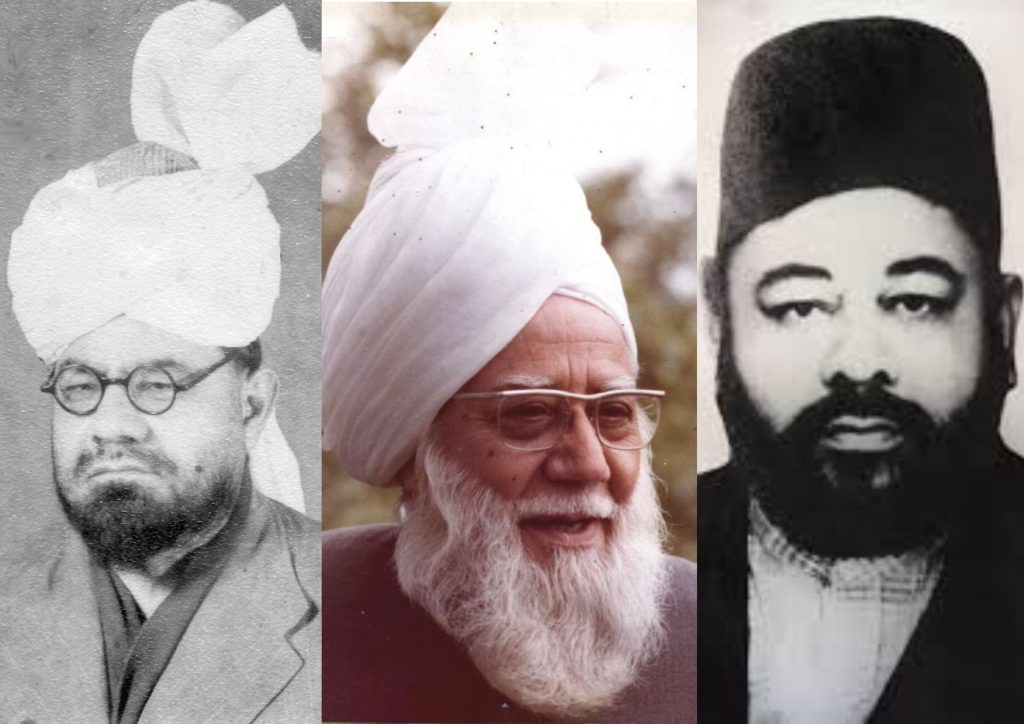
They determined the design, collected chanda (donations) from male and female companions, made decisions regarding the flag’s length, the logistics of its installation, and investigated the materials. Although most of these tasks were new to the committee members, they worked hard and submitted a report and sketches, which were then accepted by Hazrat Musleh Maud (may Allah be pleased with him).
During the donation-collecting process, there was a miscommunication in the requirements for the flag that resulted in not enough money being collected because the companions thought they each only needed to donate one paisa. Once the issue was cleared up, donations increased from 23 rupees, 8 annas, and 3 paisas to 130 rupees, which led to the successful completion of this stage.
The seed of the cotton used to prepare the flag was sewn by Hazrat Mian Faqir Muhammad Sahib (may Allah be pleased with him), a companion from Najwan, who watered and picked it himself. The cotton was then beaten by several companions, brought to Qadian, and spun by:
– Hazrat Nusrat Jahan Begum Sahiba (may Allah be pleased with her)
– Hazrat Nawab Mubaraka Begum Sahiba (may Allah be pleased with her)
– Hazrat Umm Al Hafeez Begum Sahiba (may Allah be pleased with her)
– The wife of Hazrat Khalifatul Masih al-Awwal (may Allah be pleased with her)
– The wives of Hazrat Musleh Maud (may Allah be pleased with them) and other female companions.
After that, some companions who knew this craft made cloth from the yarn. Then, some companions skilled in tailoring created the desired size. The shape of the flag was carved on this cloth from Shahdara town in Lahore. After going through all these stages, the Liwa-e-Ahmadiyya was prepared just a few days before the Jubilee Jalsa.
Before the flag was raised, Hazrat Musleh Maud (may Allah be pleased with him) asked the people of the community to fervently pray:
رَبَّنَا تَقَبَّلۡ مِنَّا إِنَّكَ أَنتَ السَّمِيعُ الْعَلِيمُ
Our Lord, accept this from us; for Thou art All-Hearing, All-Knowing.
(Surah al-Baqarah, Ch. 2: V. 128)
The flag was raised onto its 5-foot platform and then onto the flagpole. Hazrat Musleh Maud (may Allah be pleased with him) himself expressed these words of the prayer in a very emotional and loud voice. After the flag unfolded, Hazrat Musleh Maud (may Allah be pleased with him) untied the string, and as the flag rose and reached the top, slogans of Allahu Akbar erupted. At first, there was no wind, so no one could see the design, but once it reached the top, a sudden gust of wind caused the entire flag to flutter and reveal itself. The whole gathering had a clear view of it before the wind settled down again. After the completion of the ceremony, Hazrat Musleh Maud (may Allah be pleased with him) took to the stage and made the following pledge on behalf of the Jama’at:
“I bear witness that I will always continue to strive for the establishment, solidarity, and promulgation of Islam and Ahmadiyyat to the best of my ability and understanding. I will present every possible sacrifice through the help of God so that Ahmadiyyat, the [true] Islam, prevails over every other religion, its flag never falls, and, in fact, continues to wave higher than every other flag. O Allah, fulfill my prayer; O Allah, fulfill my prayer; O Allah, fulfill my prayer!”
The flag was raised at exactly 2:04 PM. It was to be guarded by 12 Khuddam, and the next day, after Jummah, the flag was handed over to two nazirs. The flag was then placed in a special lockbox with two locks and two different keys, so that only together could the nazirs open the case.
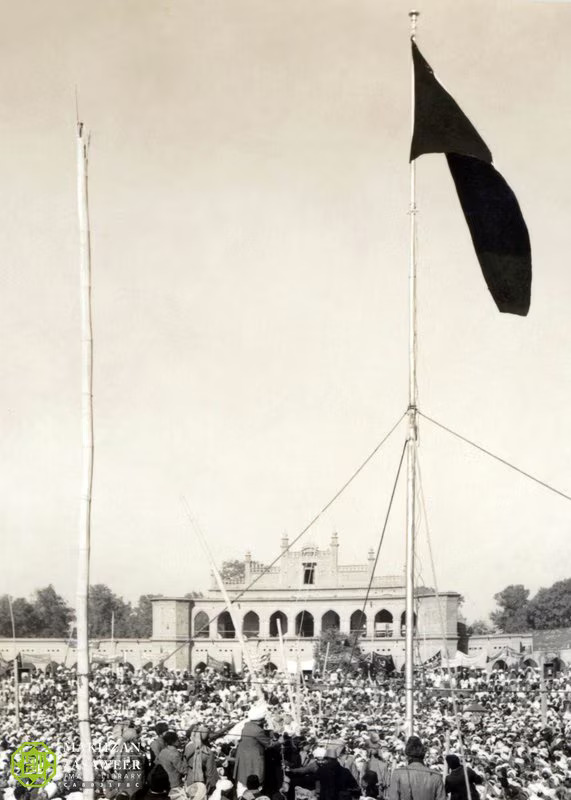
Liwa-e-Khuddam-ul-Ahmadiyya:
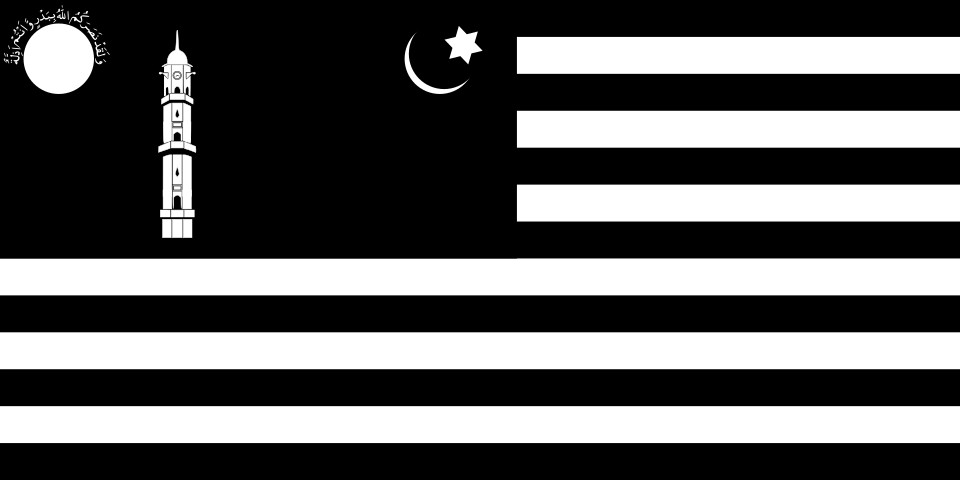
This flag was planned to be raised at the second Khuddam Ijtema on the 25th of December, 1939, but Musleh Maud (may Allah be pleased with him) said that no flag should be raised until the Liwa-e-Ahmadiyya is raised. Due to this, the Liwa-e-Khuddam-ul-Ahmadiyya was raised at Jalsa Salana Qadian on the 28th of December, 1939.
The Liwa-e-Khuddam-ul-Ahmadiyya is 18 feet long and 9 feet wide. It contains the Liwa-e-Ahmadiyya in the top left corner with 13 black and white stripes on the right. The black and white represent the centuries of ascent and decline of the Muslim Ummah.
Liwa-e-Lajna-Ima’illah:
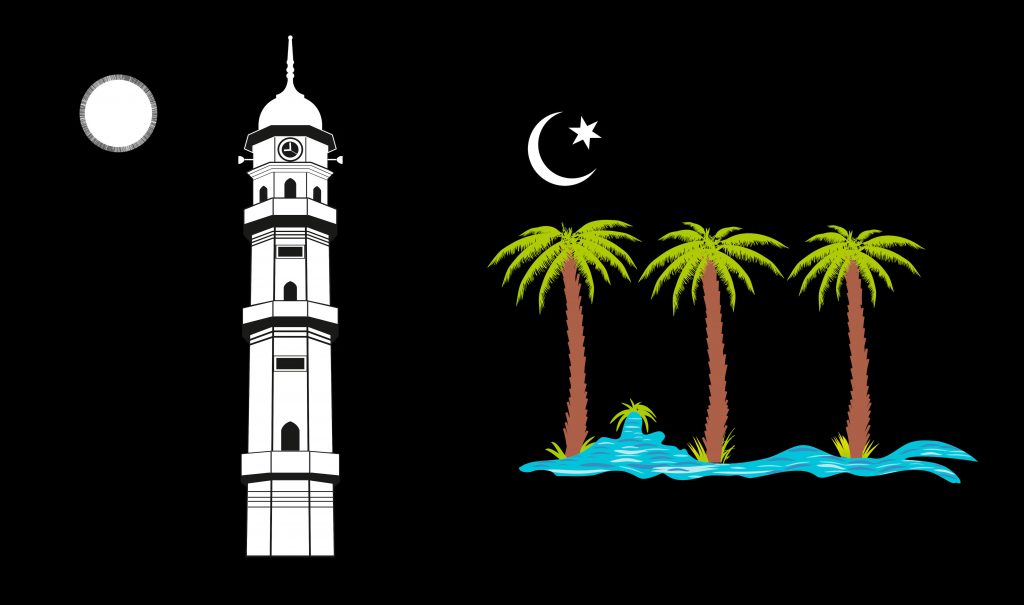
On the 28th of December, 1939, after raising the Liwa-e-Ahmadiyya and Khuddam-ul-Ahmadiyya, the Liwa-e-Lajna-Ima’illah was raised at Jalsa Qadian by Musleh Maud (may Allah be pleased with him).
The flagpole was 35 feet high, and the flag was 12 feet in length and 7 feet in width. The flag was made of satin and was stitched with a machine using different silk threads. The ladies at this moment became very excited and started shouting religious slogans. According to one source, they were initiated by Memoona Sahib, who was a teacher.
During the raising of the flag, the wives of the Khalifa and the ladies belonging to the Khandan were gathered around Huzoor (may Allah be pleased with him), including the wife of the Promised Messiah, Hazrat Nusrat Jahan Begum Sahiba (may Allah be pleased with her).
In the 1947 Partition of India, the original flag was transported from Qadian to Rabwah. However, it was misplaced. Upon investigation, it was revealed that it was left on a train arriving from Lahore to Rabwah. Other sources say that the flag disappeared in 1949 in the same way, but after the Partition of India, it was never recovered. In 1998, Amtul Quddus Sahiba, former president of Lajna, wrote to Khalifatul Masih IV (may Allah have mercy on him) seeking permission to recreate the flag since they had all the descriptions and dimensions in archives. Huzoor (may Allah have mercy on him) accepted her proposal, and thereafter the Liwa-e-Lajna-Ima’illah was recreated in 1999.
The flag was physically recreated by Khursheed Anjum Sahiba and was first hoisted at the annual Lajna Pakistan Sports Tournament and continues to be used today.
The Lawa-e-Lajna-Ima’illah also contains the Liwa-e-Ahmadiyya as part of it. The difference is that there is no Quranic verse over the Badr (full moon). On the right side, there is an oasis with 3 palm trees, representing the three great women praised in the Holy Quran: Hazrat Hajra (may Allah be pleased with her), Hazrat Maryam (may Allah be pleased with her), and Hazrat Amina (may Allah be pleased with her). The crescent symbolizes a new era emerging from the spiritual darkness of modern times. The 6-point star denotes the 6 articles of faith. The white minaret represents the fulfillment of the prophecy of the coming of the Promised Messiah (peace be upon him). The sun rising from the west denotes the success of Islam in the Western world. Some sources mention that on the right is a Badr (full moon), while others claim that it represents the sun, but the strongest source identifies it as the full moon. The oasis symbolizes motherhood.
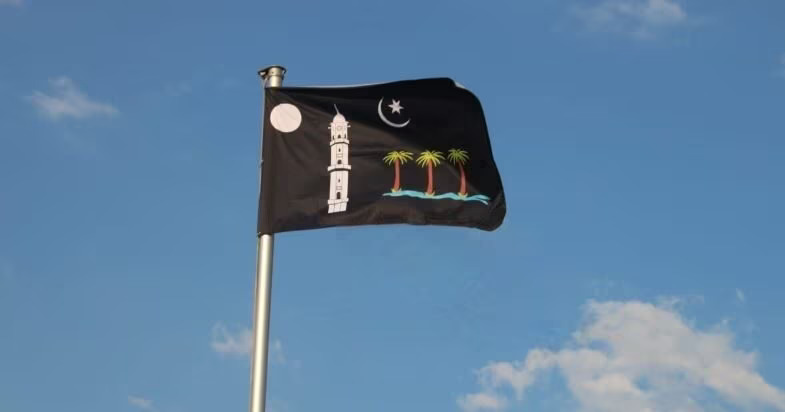
Liwa-e-Ansarullah:

At the annual Ijtema in 1956, the Majlis-e-Shura of Ansarullah decided that Ansarullah should have its own flag. A subcommittee was formed to devise and develop the practical details of implementing this decision. Some members of this committee included Hazrat Mirza Nasir Ahmad (may Allah have mercy on him) and Maulana Jalaluddin Shams Sahib (may Allah be pleased with him). The reason Ansarullah didn’t have a flag earlier is that they were founded on July 26, 1940, a year after the other flags were made.
In the top left corner of the Ansarullah flag, there is a black square with a full moon inside it. The use of black comes from the Hadith, which states that the flag of the Prophet Muhammad (peace and blessings of Allah be upon him) was black. Since it is a subordinate flag of the Liwa-e-Ahmadiyya, it needs to have black in it. The moon represents the claim of the Promised Messiah (peace be upon him), who manifested himself like a full moon. The remaining white area represents piety, peace, enlightenment, and light. The stripes of decline from the Khuddam flag are removed, leaving only white, which represents purity and other virtuous attributes.
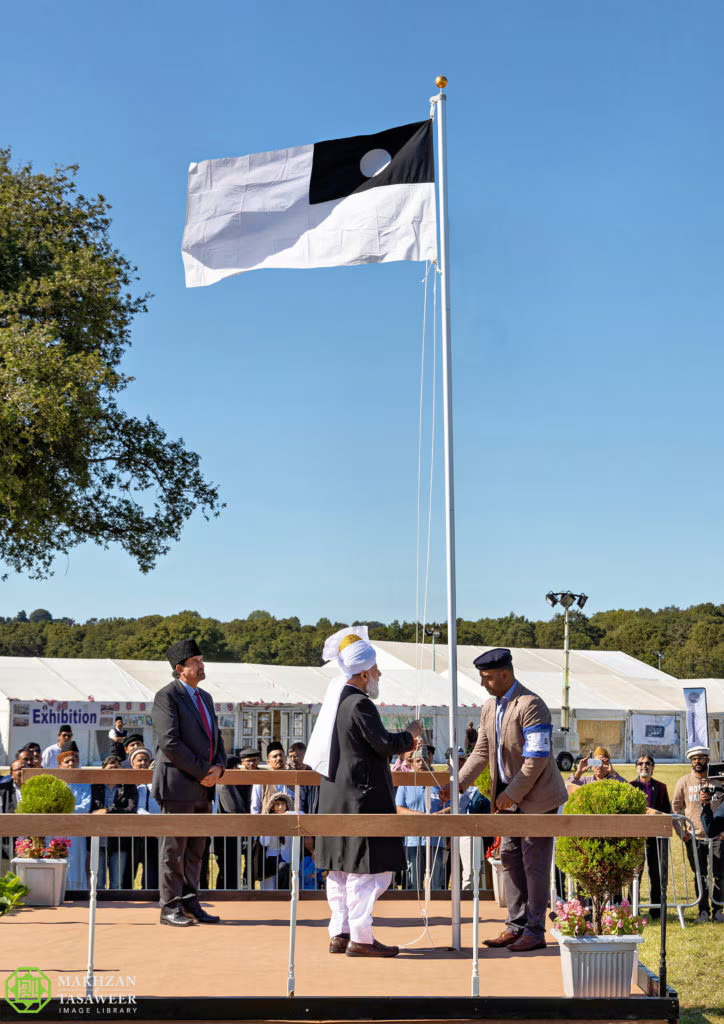
The flags of Jama’at Ahmadiyya – Liwa-e-Ahmadiyya, Liwa-e-Khuddam-ul-Ahmadiyya, Liwa-e-Lajna-Ima’illah, and Liwa-e-Ansarullah – each carry deep historical and spiritual significance and represent a unique chapter in the community’s journey. Their creation, a product of the collective effort and devotion of the Jama’at, stands as a testament to the faith and commitment of those who made it. These flags are not just pieces of fabric – they symbolize the spiritual aspirations and unwavering dedication to the propagation of true Islam.
Today, these flags continue to inspire, serving as a powerful reminder of the community’s past while also pointing toward a united and spiritually driven future.
